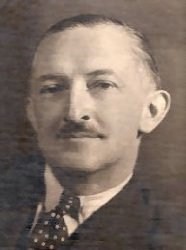
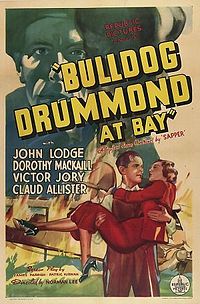 Bulldog Drummond (1941-49) aired “Death Uses Disappearing Ink” on June 9, 1948. This is only the fourth Drummond episode we have run, the first three all coincidentally presented in January of 2015, 2016, and 2017, so it has been well over a year and a half since last we visited him. If you like James Bond you’ll find a lot to like in Hugh “Bulldog” Drummond’s adventures. Bulldog Drummond was the character created by Englishman H. C. McNeile (1888-1937, photo at left), who wrote under the pseudonym of “Sapper,” Sapper being the official term for those serving in the Royal Engineers during World War I, and the name suggested by McNeile’s publisher in order to lend the stories an air of authenticity. None other than Ian Fleming, creator of James Bond, wrote of Bulldog Drummond’s author that he was “Sapper from the waist up and Mickey Spillane below.”
Bulldog Drummond (1941-49) aired “Death Uses Disappearing Ink” on June 9, 1948. This is only the fourth Drummond episode we have run, the first three all coincidentally presented in January of 2015, 2016, and 2017, so it has been well over a year and a half since last we visited him. If you like James Bond you’ll find a lot to like in Hugh “Bulldog” Drummond’s adventures. Bulldog Drummond was the character created by Englishman H. C. McNeile (1888-1937, photo at left), who wrote under the pseudonym of “Sapper,” Sapper being the official term for those serving in the Royal Engineers during World War I, and the name suggested by McNeile’s publisher in order to lend the stories an air of authenticity. None other than Ian Fleming, creator of James Bond, wrote of Bulldog Drummond’s author that he was “Sapper from the waist up and Mickey Spillane below.”
McNeile, who fought on the Western front in WWI and retired as a major in 1919, wrote a few stories during the war about Drummond as a detective but to no great success. With his first Drummond novel in 1920 (he would pen a total of ten until his death in 1937), Bulldog Drummond, Captain Hugh Drummond, DSO, MC, and ex-British army, was a detective no longer, but would become an adventurer bored with civilian life and, seeking excitement, would place an ad in the newspaper which read: “Demobilised officer, finding peace incredibly tedious, would welcome diversion. Legitimate, if possible, but crime, if of a comparatively humorous description, no objection. Excitement essential. Would be prepared to consider permanent job if suitably impressed by applicant for his services. Reply at once Box X10.”
 After rejecting the first few responses to his ad, Drummond accepts one from a distraught “damsel in distress” by the name of Phyllis Benton, whom he would end up marrying by the end of the novel. Phyllis’ problem, that for which she has enlisted Drummond’s aid, soon involves him in a deadly adventure with his soon-to-be recurring nemesis Carl Peterson, an evil genius and megalomaniac bent on world (and Communist) domination, his first conquest being Great Britain. The book is full of action and graphic violence, including a scene where a sociopathic torturer is shoved into an acid bath he has used on others. Not wishing to make certain he dies a quick death, Drummond allows him to throw himself out of the acid bath with his clothes smoking and his flesh bubbling and in agony, only to meet a terrible death a short while later. Sapper has Drummond pull no punches in his encounters with the truly evil. Through circumstance–and the bumbling police–Peterson escapes to commit evil another day, which he does for three more novels until his fitting demise.
After rejecting the first few responses to his ad, Drummond accepts one from a distraught “damsel in distress” by the name of Phyllis Benton, whom he would end up marrying by the end of the novel. Phyllis’ problem, that for which she has enlisted Drummond’s aid, soon involves him in a deadly adventure with his soon-to-be recurring nemesis Carl Peterson, an evil genius and megalomaniac bent on world (and Communist) domination, his first conquest being Great Britain. The book is full of action and graphic violence, including a scene where a sociopathic torturer is shoved into an acid bath he has used on others. Not wishing to make certain he dies a quick death, Drummond allows him to throw himself out of the acid bath with his clothes smoking and his flesh bubbling and in agony, only to meet a terrible death a short while later. Sapper has Drummond pull no punches in his encounters with the truly evil. Through circumstance–and the bumbling police–Peterson escapes to commit evil another day, which he does for three more novels until his fitting demise.
The third Bulldog Drummond novel, The Third Round (1924), gets into Bond territory (and SF) with some pseudo-science involved in the creation of synthetic diamonds. Arch nemesis, and identity-chameleon Peterson is back, whose only desire is to exploit the discovery. Sapper is getting the hang of how to write these books by this time, and it shows. These first four Drummond novels are known as the Carl Peterson Quartet, and are recommended for their action, plotting (in most cases), wild adventure, and a hero who knows good from evil, is smart, but hardly handsome, and is definitely a product of his time (that of post-WWI England, with its prejudices and views of those nations from which it has just emerged from a devastating war), and of Sapper himself, who puts much of his own military experience into the books, and surrounds Drummond with fictional army pals including his best friend Algy Longworth, his manservant James Denny (who you will hear in this radio episode), army buddy Peter Darrell, and other series regulars Toby Sinclair and Ted Jerningham. The Carl Peterson quartet of novels are collected in one volume by Wordsworth Editions (2007, 768 pp., though Amazon incorrectly has it at 320 pp., cover above right) and can be purchased via Amazon here.
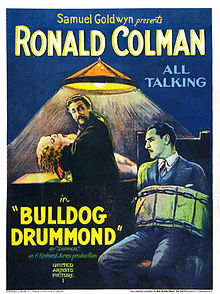 From the 1920s through the 1960s Bulldog Drummond was featured in 23 films. The first two (1922, 1925) were silent, but the third in 1929 with the eponymous title Bulldog Drummond starred Ronald Colman in his first talkie. The period of 1930-47 saw 17 Drummond films, a fair number including one of the famed Barrymore family, John, while Ray Milland would star in 1937’s Bulldog Drummond Escapes. The pair of Drummond films in 1948 would star no less than Tom Conway, and in 1951 Walter Pidgeon would star as Drummond in Calling Bulldog Drummond. An attempt to cash in on the James Bond movie craze in the 1960s saw two more Drummond films (Deadlier than the Male, 1967, and Some Girls Do, 1969), but with little success. The Bulldog Drummond character and adventures were so popular in Britain that in his early days while living in England, young up-and-coming film director Alfred Hitchcock sought the rights to the Drummond character for a film he was set to make titled Bulldog Drummond’s Baby. British International Pictures would not release the rights, so Hitchcock turned his film into the now classic The Man Who Knew Too Much (1934, starring Peter Lorre) without the Bulldog Drummond character. Hitchcock would remake the film in 1956 starring James Stewart and Doris Day.
From the 1920s through the 1960s Bulldog Drummond was featured in 23 films. The first two (1922, 1925) were silent, but the third in 1929 with the eponymous title Bulldog Drummond starred Ronald Colman in his first talkie. The period of 1930-47 saw 17 Drummond films, a fair number including one of the famed Barrymore family, John, while Ray Milland would star in 1937’s Bulldog Drummond Escapes. The pair of Drummond films in 1948 would star no less than Tom Conway, and in 1951 Walter Pidgeon would star as Drummond in Calling Bulldog Drummond. An attempt to cash in on the James Bond movie craze in the 1960s saw two more Drummond films (Deadlier than the Male, 1967, and Some Girls Do, 1969), but with little success. The Bulldog Drummond character and adventures were so popular in Britain that in his early days while living in England, young up-and-coming film director Alfred Hitchcock sought the rights to the Drummond character for a film he was set to make titled Bulldog Drummond’s Baby. British International Pictures would not release the rights, so Hitchcock turned his film into the now classic The Man Who Knew Too Much (1934, starring Peter Lorre) without the Bulldog Drummond character. Hitchcock would remake the film in 1956 starring James Stewart and Doris Day.
 1937-39 would prove arguably the best years for Bulldog Drummond films, when Paramount would make nine of the short B films, most running to around 60 minutes give or take. For anyone wishing to introduce themselves to these fun, suspenseful action forays I recommend picking up the 2006 Mill Creek Entertainment boxed set titled Mystery Classics. It’s one of those “100 Movie Pack” sets reasonably priced with some real gems (along with a few easily forgotten pictures), but including a majority of interesting, entertaining films including six Bulldog Drummond titles: Bulldog Drummond’s Revenge (1937), Bulldog Drummond Escapes (w/Ray Milland, 1937), Bulldog Drummond Comes Back (1937), Bulldog Drummond in Africa (1938), Bulldog Drummond’s Peril (1938), and Bulldog Drummond’s Secret Police (1939). These films stick pretty close (in general) to the original Drummond world as depicted in the novels, save for one striking departure; in the first novel, Bulldog Drummond (1920), Drummond marries Phyllis Benton, while in the movies he’s always about to be married–just at the altar, as it were–when something inevitably happens to postpone or otherwise thwart the ceremony, thus making poor dear Phyllis always the understanding, long-suffering bride-to-be whom Drummond is always promising to marry as soon as the current adventure is concluded. It’s a humorous bit replayed in several of the films, and the actress plays the bit to great advantage.
1937-39 would prove arguably the best years for Bulldog Drummond films, when Paramount would make nine of the short B films, most running to around 60 minutes give or take. For anyone wishing to introduce themselves to these fun, suspenseful action forays I recommend picking up the 2006 Mill Creek Entertainment boxed set titled Mystery Classics. It’s one of those “100 Movie Pack” sets reasonably priced with some real gems (along with a few easily forgotten pictures), but including a majority of interesting, entertaining films including six Bulldog Drummond titles: Bulldog Drummond’s Revenge (1937), Bulldog Drummond Escapes (w/Ray Milland, 1937), Bulldog Drummond Comes Back (1937), Bulldog Drummond in Africa (1938), Bulldog Drummond’s Peril (1938), and Bulldog Drummond’s Secret Police (1939). These films stick pretty close (in general) to the original Drummond world as depicted in the novels, save for one striking departure; in the first novel, Bulldog Drummond (1920), Drummond marries Phyllis Benton, while in the movies he’s always about to be married–just at the altar, as it were–when something inevitably happens to postpone or otherwise thwart the ceremony, thus making poor dear Phyllis always the understanding, long-suffering bride-to-be whom Drummond is always promising to marry as soon as the current adventure is concluded. It’s a humorous bit replayed in several of the films, and the actress plays the bit to great advantage.
The 1920s and 30s were the heyday of the Drummond novels and films, but American radio would catch up in the 1940s with the Bulldog Drummond radio series, where now Drummond has moved to the United States to continue his adventures, of which “Death Uses Disappearing Ink” is one. While the American radio incarnation of Bulldog Drummond is slightly watered down in terms of the graphic violence appearing in the novels, this episode does involve murders of more than one variety. Captain Drummond and loyal manservant James Denny find themselves on a train with an assassin, undercover police, and a beautiful woman. But as you might suspect, all is not as it seems as Drummond must unravel lies, motives, and the truth in order to save an innocent man from dying–and it’s not easy or pretty. So sit back and enjoy this tale of deception and misdirection to discover how “Death Uses Disappearing Ink” figures into the plot.
Play Time: 26:03
{After listening to this episode of Bulldog Drummond, and because the new kid on the block was a crime/mystery fan with quite a good collection he had impressed his new friends with, the neighborhood gang found themselves at the corner newsstand poring over the latest issues of some of their favorites. Black Mask (1920-51) was the legendary gold standard of crime/detective pulps so was an easy choice. It was a bi-monthly in 1948. Dime Detective (1931-53) looked like a good bet for some down and dirty, page-turning action, and it didn’t hurt that there was a John D. MacDonald cover story to seal the deal. It was a monthly in 1948. Dime Mystery (1932-50) was hard to resist with its eye-catching cover–a scantily clad woman being threatened by a skeletal entity of pure evil–some minion of Satan no doubt if not the Dark One himself, and was a sure draw for fans of the supernatural who were also fans of Weird Tales. Though it published a January issue, Dime Mystery would go bi-monthly with its February issue and finished 1948 with 7 issues.}
[Left: Black Mask, July 1948 – Center: Dime Detective, June 1948 – Right: Dime Mystery, June 1948]
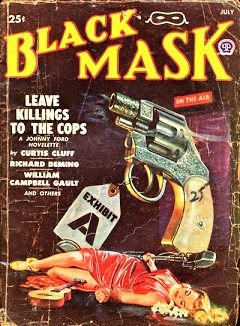
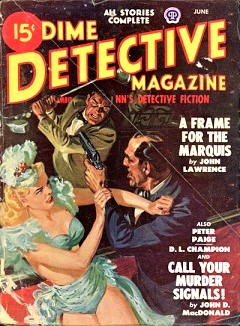
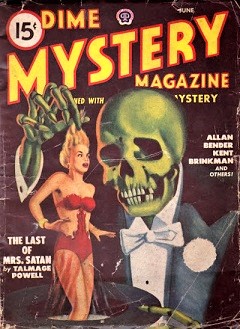
To view the entire list of weekly Old Time Radio episodes at Tangent Online, click here.